Introduction to Clean Disruption and Its Implications
Clean Disruption
Introduction to Clean Disruption and Its Implications
Introduction
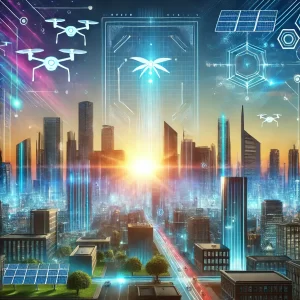 In a world constantly evolving through technology, it’s not just about keeping pace with the changes—it’s about staying ahead of them. Tony Seba’s groundbreaking book, Clean Disruption of Energy and Transportation, presents a thesis that fundamentally challenges the status quo of today’s energy and transportation industries. According to Seba, by 2030, the industrial age of energy and transportation as we know it will be over, swept away by exponentially advancing technologies such as solar power, electric vehicles, and autonomous (self-driving) cars. These technologies are poised to disrupt and displace the fossil fuel industry, utility companies, and traditional transportation, creating a seismic shift that will impact millions of jobs and redefine entire industries.
In a world constantly evolving through technology, it’s not just about keeping pace with the changes—it’s about staying ahead of them. Tony Seba’s groundbreaking book, Clean Disruption of Energy and Transportation, presents a thesis that fundamentally challenges the status quo of today’s energy and transportation industries. According to Seba, by 2030, the industrial age of energy and transportation as we know it will be over, swept away by exponentially advancing technologies such as solar power, electric vehicles, and autonomous (self-driving) cars. These technologies are poised to disrupt and displace the fossil fuel industry, utility companies, and traditional transportation, creating a seismic shift that will impact millions of jobs and redefine entire industries.
As these changes unfold, the question arises: how can you protect your future and control your destiny in such a rapidly changing world? The answer lies in developing a personal digital marketing business. In this blog series, we will explore how the impending clean disruption offers not only challenges but also unprecedented opportunities for those who are prepared. And we will show you how enrolling in the course Mastering the Art of Wealth Creation: A Journey Through Mind Power and Marketing can equip you with the tools and mindset needed to thrive in this new era.
Understanding Clean Disruption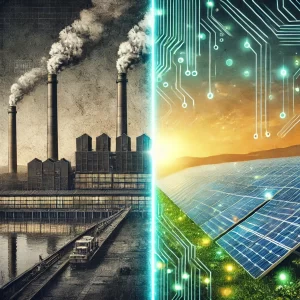
Tony Seba’s thesis on clean disruption revolves around the idea that the traditional, centralized, and resource-extraction-based energy and transportation industries are on the verge of being replaced by more efficient, sustainable, and decentralized alternatives. Much like the transition from the Stone Age to the Bronze Age, this shift isn’t happening because we’re running out of fossil fuels or nuclear energy. Instead, it’s happening because new technologies—powered by bits and electrons rather than atoms—are simply better, cheaper, and more participatory.
The cornerstone of this disruption is the rapid improvement in technologies like solar energy, electric vehicles, and autonomous driving. These innovations are creating a new architecture of energy and transportation that is decentralized, abundant, and driven by information technology. The impact of this transition will be profound, affecting everything from how we power our homes to how we move goods and people.
The Predicted Changes in Energy and Transportation
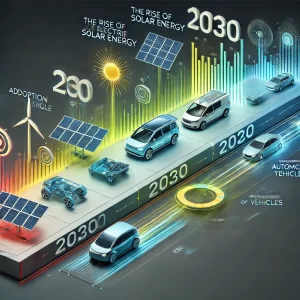 Seba’s predictions are startling in their scope and immediacy. By 2030, the energy landscape will be dominated by solar power, which is rapidly becoming the cheapest and most scalable energy source available. Electric vehicles (EVs) are set to replace traditional internal combustion engine (ICE) vehicles, not just because they are cleaner, but because they are becoming more cost-effective to produce and maintain. Autonomous vehicles will further disrupt the transportation industry, eliminating the need for car ownership and reducing the demand for fossil fuels.
Seba’s predictions are startling in their scope and immediacy. By 2030, the energy landscape will be dominated by solar power, which is rapidly becoming the cheapest and most scalable energy source available. Electric vehicles (EVs) are set to replace traditional internal combustion engine (ICE) vehicles, not just because they are cleaner, but because they are becoming more cost-effective to produce and maintain. Autonomous vehicles will further disrupt the transportation industry, eliminating the need for car ownership and reducing the demand for fossil fuels.
These changes are not distant possibilities—they are already beginning to unfold. Solar energy installations are surging globally, EV sales are skyrocketing, and major automakers are committing to phasing out ICE vehicles. The clean disruption is not just a theory; it’s an ongoing transformation that will accelerate in the coming years.
The Impact on Traditional Jobs and Industries 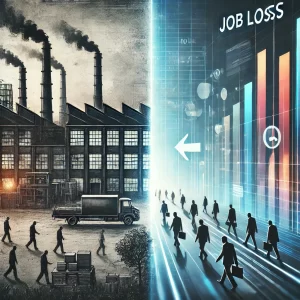
The transition to clean energy and advanced technologies like autonomous vehicles will inevitably lead to significant job displacement across various traditional industries. Several studies and reports have provided estimates on the scale of this disruption:
1. Fossil Fuel Industry:
•Job Losses: According to a report by the International Labour Organization (ILO), the shift towards renewable energy could result in the loss of approximately 6 million jobs in the fossil fuel industry by 2030. This includes jobs in coal mining, oil and gas extraction, and related industries .
2. Automotive Manufacturing:
•Job Losses: The transition to electric vehicles (EVs) and autonomous vehicles is expected to reduce the need for labor in traditional automotive manufacturing. McKinsey & Company estimates that by 2030, about 30% of the 15 million automotive manufacturing jobs worldwide could be at risk, equating to approximately 4.5 million jobs .
3. Transportation Sector:
•Job Losses: Autonomous vehicles are projected to disrupt the transportation sector significantly. According to a study by the Center for Global Policy Solutions, the widespread adoption of autonomous vehicles could displace up to 4.1 million driving jobs in the United States alone, including truck drivers, delivery drivers, and taxi drivers .
4. Utilities and Energy Sector:
•Job Losses: As traditional power generation from coal and nuclear plants declines, there will be a reduction in related jobs. The Bureau of Labor Statistics (BLS) estimates that coal mining jobs could decline by 47% between 2019 and 2030, which could result in the loss of around 35,000 jobs in the U.S. alone .
Sources:
•International Labour Organization (ILO): World Employment and Social Outlook 2018: Greening with Jobs
•McKinsey & Company: The Future of Jobs in the Automotive Industry
•Center for Global Policy Solutions: Stick Shift: Autonomous Vehicles, Driving Jobs, and the Future of Work
•Bureau of Labor Statistics (BLS): Employment Projections: 2019-2029
These estimates highlight the significant potential for job displacement as a result of the clean disruption. However, while these traditional jobs are at risk, new opportunities in renewable energy, digital marketing, and technology sectors are expected to arise, offering avenues for reemployment and career transition..
The Importance of Being Aware of These Changes
![]() In the face of such profound changes, awareness and preparation are crucial. Understanding the forces driving the clean disruption allows you to make informed decisions about your career, investments, and business ventures. It also empowers you to take proactive steps to protect your future and ensure you are not left behind as the world moves forward.
In the face of such profound changes, awareness and preparation are crucial. Understanding the forces driving the clean disruption allows you to make informed decisions about your career, investments, and business ventures. It also empowers you to take proactive steps to protect your future and ensure you are not left behind as the world moves forward.
This is where developing a personal digital marketing business becomes a vital strategy. By building a business that harnesses the power of digital marketing, you can create a source of income that is flexible, scalable, and aligned with the emerging trends in technology and consumer behavior. You can position yourself at the forefront of the new economy, rather than clinging to outdated models that are destined to become obsolete.
Call to Action: Prepare for the Future with Our Course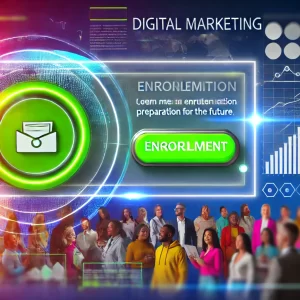
As we continue this blog series, we will delve deeper into the specific strategies and opportunities available to those who choose to embrace digital marketing as a means of securing their future. We will explore the tools, techniques, and mindsets that will enable you to thrive in a world transformed by clean disruption.
To take the first step on this journey, we invite you to enroll in our course, Mastering the Art of Wealth Creation: A Journey Through Mind Power and Marketing. This course offers a comprehensive blueprint for developing a successful digital marketing business, providing you with the skills and insights needed to navigate the challenges and seize the opportunities of the coming disruption.
The future is coming, whether we are ready for it or not. By taking action now, you can ensure that you are not just a passive observer but an active participant in shaping your destiny in this new era.

John Rogers is a former Wall Street portfolio manager and served as CEO of Premium Enterprises and President of The Colorado Tire Recycling Center. He transitioned to digital marketing, founding WealthCreationMastermind.com to empower home-based entrepreneurs with cutting-edge strategies. Creator of the “Mastering the Art of Wealth Creation” online course, John has driven significant growth in network marketing, achieving the Blue Diamond rank and earning the title of Univera Associate of the Year in 2015. His expertise in leveraging technology for financial success transforms how entrepreneurs achieve their business goals.